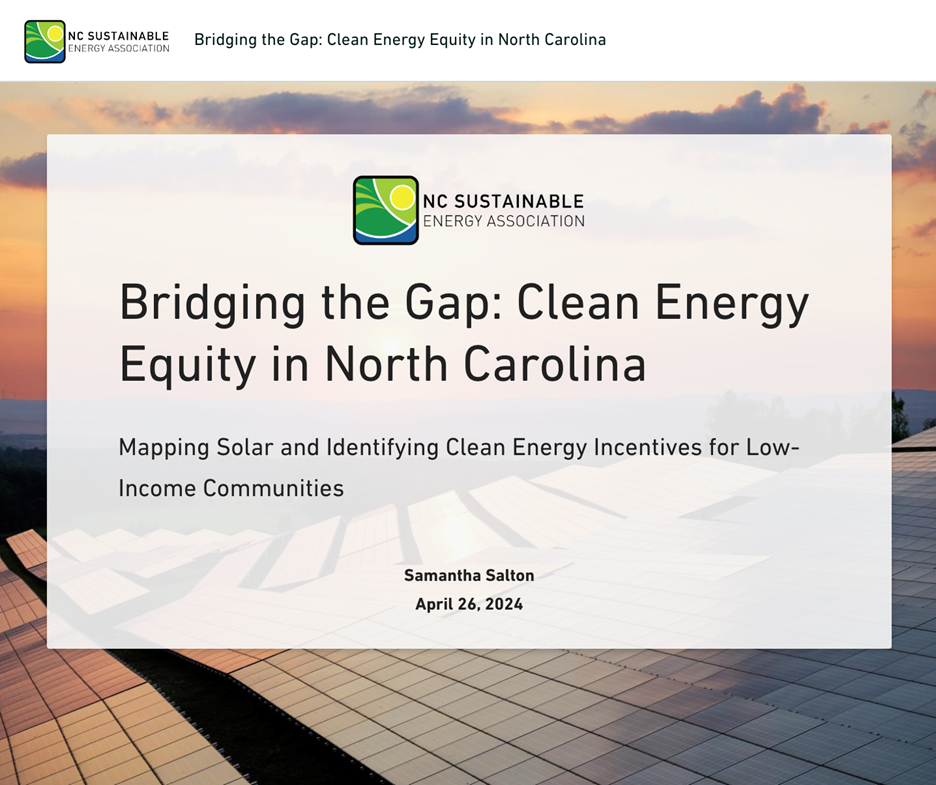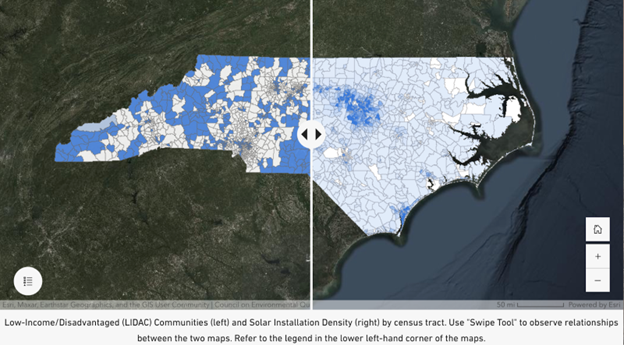Areas of the state with a high density of solar installations, particularly metropolitan regions such as Charlotte, Raleigh, and Greensboro, have a lower prevalence of disadvantaged communities by census tract. These urban areas benefit from greater access to financial resources, incentives, and information regarding clean energy access, facilitating higher rates of solar adoption. Additionally, urban residents often have better access to information about solar companies and installation services, which simplifies the process. On the other hand, the northeastern and southern regions of the state are sparsely populated with solar installations and have a higher prevalence of disadvantaged communities by census tract. Many of these LIDAC tracts are rural, minority, and low-income communities that have limited access to the educational resources necessary to better understand the residential solar installation process, but could stand to benefit the most from the adoption of clean energy technologies.
Residential solar provides significant benefits to both individual owners and the grid as a whole. For homeowners, solar panels reduce electricity bills, increase property values, contribute to a lower carbon footprint, and provide resiliency and independence during a grid outage. In terms of the electricity grid, residential solar lowers overall demand, enhances grid stability and reliability, reduces transmission losses, and supports economic growth through job creation in the solar industry. Widespread solar adoption further reduces reliance on fossil fuels, leading to lower carbon emissions and cleaner air. However, the lack of solar installations in certain areas perpetuates energy inequity, as many residents in LIDAC communities across North Carolina miss out on the environmental and economic benefits of solar energy. Educational initiatives about the benefits and feasibility of solar energy, both in front of and behind the meter, empower residents to advocate for and invest in renewable energy solutions.
In addition to mapping disparities in solar access, the StoryMap includes detailed clean energy case studies from various low-income households and communities across the state. These stories showcase the successful implementation of residential solar projects and provide an idea of the resources and opportunities that could be available to residents seeking out clean energy or energy efficiency upgrades. There are a number of agencies and programs in the state that offer vital energy services to disadvantaged communities, such as the NC Weatherization Assistance Program and Duke Energy’s Helping Home Fund. Unfortunately, the demand for these services always dwarfs the supply. There is also a need for these various programs to collaborate and pool their resources so they can better tailor services to meet the needs of low-income residents.
As an example of this type of coordination, starting in 2022, NCSEA received funding from Orange County, Coastal Credit Union and the NC Department of Environmental Quality (DEQ) to implement the Neighborhood Energy Resiliency Project (NERP). This initiative focused on improving the energy efficiency and structural integrity of homes in a historically disadvantaged neighborhood in Carrboro, North Carolina. Meanwhile, the Solarize the Triangle program was working in the same territory to identify suitable homes for no-cost solar installations as part of their initiative to support low-to-moderate-income households. Through collaboration with the Central Pines Regional Council, NCSEA was able to refer a home for solar from the NERP project to Solarize the Triangle, maximizing the benefits of both programs for residents. Through work in NERP, NCSEA was able to identify the home as a good candidate for solar, reducing the redundancy in service applications and increasing the likelihood of residents receiving the most appropriate assistance for their needs.
Within the clean energy resources guide section of the StoryMap, users can easily navigate through detailed information on programs like EnergizeNC, utility initiatives, and other state and federal incentives specifically tailored to support residential solar energy adoption. Highlighted first is the Energy Funds for All website, a comprehensive resource guide designed to provide clear access to federal climate funds. This valuable resource is accessible to a wide range of stakeholders, including homeowners, renters, and municipalities throughout North Carolina and South Carolina. Additionally, the NC Solar Consumer Guide outlines several incentives available at the federal and state levels designed to help lower the overall installation cost of solar in North Carolina.
Barriers to Access and the Path Forward
Several barriers currently limit the widespread adoption of residential solar among low-income NC residents. Often, the upfront cost of purchasing and installing solar panels presents a significant financial obstacle. Despite the potential long-term savings on electricity bills, many residents struggle to cover the initial investment required for solar energy systems. Additionally, the state’s existing incentive programs and utility payback structure to compensate residents for excess energy produced by solar systems may not sufficiently encourage residential solar adoption, further dampening enthusiasm for investment in residential solar. As for renters, there is limited incentive for landlords to invest in residential solar for their tenants given that they typically bear the upfront costs while tenants reap the benefits. Meeting the conditions necessary for residential solar installations, such as ensuring structural integrity and sufficient sun exposure, can also pose challenges, especially in older homes or homes where residents cannot afford the necessary upgrades.
Addressing the significant disparities in solar energy adoption across North Carolina requires targeted interventions and policies aimed at reducing the financial and informational barriers to solar adoption, particularly in LIDAC communities. Initiatives like Solar for All and EnergizeNC are essential steps in the right direction. By focusing on the equitable distribution of solar energy resources, North Carolina can ensure that all residents, regardless of their income level or geographic location, can participate in and benefit from the state’s growing clean energy economy. Bridging the gap between areas with low and high rates of adoption will not only advance environmental justice but also strengthen the resilience and sustainability of communities across the state.


